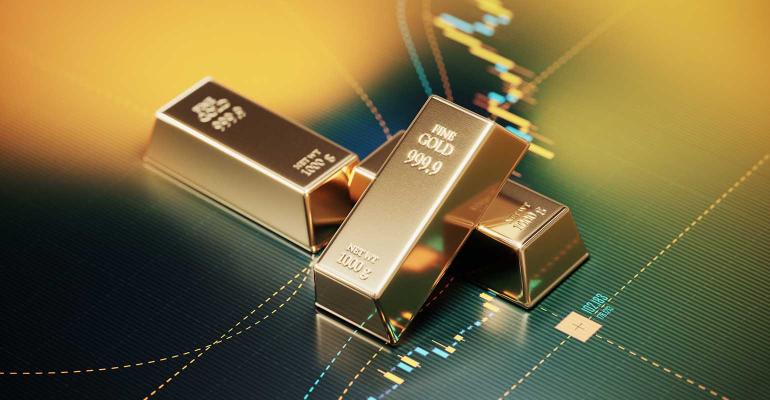(Bloomberg Opinion) -- Gold has definitively broken out of the range it's been stuck in since the start of this decade, reaching a record $2,195 per troy ounce this month. While a surge of buying from China is likely behind the recent rally, some of the more conventional factors that typically propel the yellow metal are starting to fall into line. Fresh records beckon.
China has been diversifying its state foreign reserves into gold for much of the past decade, though reporting of its activity has been patchy. Whether China continues to add at record prices is now a big question, but appetite from the nation’s wealthy individuals seems to remain unsated.
Physical exports of gold to China from Switzerland nearly trebled in January, according to the Swiss Federal Customs Administration. That points to Chinese individuals looking for a haven in the most ancient form of financial security following a rocky period for the country's real estate and equity markets.
There are other signs that gold demand is picking up more broadly. Societe Generale SA analysts reported record monthly fund manager flows into gold in February, worth $11.3 billion. COMEX gold futures have seen the biggest uptick in net new longs in five years in the past two weeks, though exposure is still not close to the record for open positions, standing at 426,000 contracts currently versus 550,000 contracts held at the end of 2019.
The reduction in gold-related exchange-traded fund holdings remains puzzling. These typically track the gold price quite closely, but the pairing has diverged dramatically since late 2022. February saw the ninth consecutive monthly outflow from physically backed ETFs, with $5.7 billion sold so far this year. Nonetheless, those outflows have been little match for blistering central bank demand, which has exceeded 1,000 metric tons of purchases annually for two consecutive years.
Gold’s performance — or lack thereof — in recent years has confused analysts. Conventional logic would have anticipated new highs when the Federal Reserve triggered its huge pandemic monetary stimulus program. But the subsequent spike in inflation, driven in large part by surging energy prices, has been accompanied by a breakdown in the the correlations of gold to other asset classes. Rising interest rates should have been bad for gold and outbreaks of war beneficial, but the reaction was minimal.
According to Chris Watling, founder of investment consultancy Longview Economics, the big three historical drivers of gold prices are the dollar, inflation expectations and interest-rate forecasts. Those are starting, belatedly, to assert themselves.
The dollar index has fallen nearly 4% since the start of November, making the metal cheaper to buy. Inflation has been slowing consistently for a while so it's tough to give that much credit for gold’s recent run. The expert way to track gold’s relationship with the monetary side of the economy is to monitor bond yields after adjusting for inflation. The yield on the 10-year US Treasury inflation-linked bonds has fallen by 20 basis points to around 1.8% since mid-February; falling real yields underpin the gold rally as parking money in bonds becomes relatively less attractive. Meantime, the Fed interest-rate cuts the futures market is anticipating in the second half of this year should support higher gold prices.
For gold bugs, its fundamental allure comes from the contrast with currencies backed by nothing more substantial than spendthrift governments. US fiscal deficits, for example, are poised to increase for the next decade, according to the Congressional Budget Office. The accompanying increase in debt issuance will be relentless — adding to the bull case for enthusiasts of the precious metal. And while Bitcoin’s recent record highs have been spurred by the introduction of cryptocurrency ETFs, the underlying driver of demand is a similar disdain for fiat currencies.
Rather than simply wondering whether China has or hasn’t bought another truckload of ingots, investors have some less intangible arguments for allocating more money to the metal. Escalating geopolitical tensions, the prospect of troubled elections in several countries and an increasingly favorable economic backdrop for gold should pave the way for fresh highs.
More From Bloomberg Opinion:
- The Fed Isn't Gonna Carry That Weight for Gold: John Authers
- Bitcoin ETF Hype Is More Memestock Than Gold 2.0: Lionel Laurent
- Gold's Fickleness Makes It Bitcoin for Boomers: Marcus Ashworth
Want more from Bloomberg Opinion? OPIN <GO>. Or subscribe to our daily newsletter .
To contact the author of this story:
Marcus Ashworth at [email protected]

